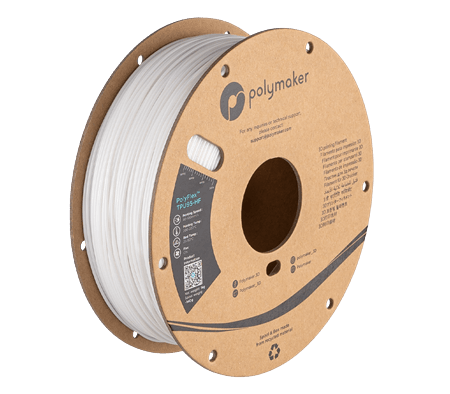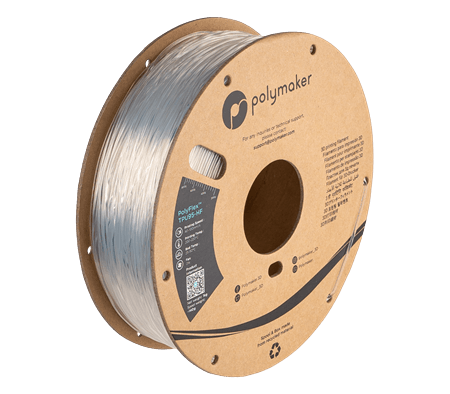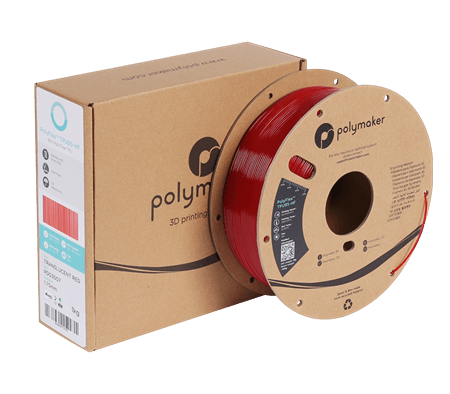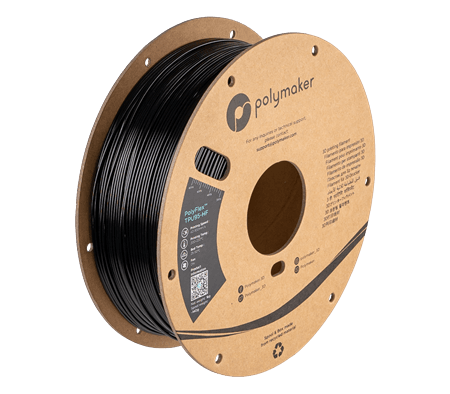Polymaker
Polymaker PolyFlex TPU95-HF High Speed 1kg 1.75mm Filament
Polymaker PolyFlex TPU95-HF High Speed 1kg 1.75mm Filament
Low stock: 3 left
Couldn't load pickup availability
Industrial TPU engineered for high speed printing, featuring UV resistance and 95A Shore hardness
- Flexible Polymaker TPU with 95A shore hardness.
- Developed for high speed / high flow 3D printing.
- Excellent UV resistance.
- Exceptional durability, impact resistance & shape memory..
- Formulated for wide printer compatibility.
- Consistent colour and tolerance (1.75mm diameter +/- 0.03mm)

PolyFlex™ is a family of high-quality flexible materials. It provides the perfect solution for applications where high flexibility and durability are required. PolyFlex™ TPU95-HF, created from Covestro’s Addigy®️ family, is a TPU with high flow properties making it ideal for high speed printing. Combined with its UV resistance, PolyFlex™ TPU95-HF unlocks new applications for flexible materials in manufacturing.
Features
Rapid 3D Printing - The high flow of PolyFlex™ TPU95-HF allows it to have a low viscosity at low temperatures, therefore for the same amount of pressure from the extruder, PolyFlex™ TPU95-HF is able to extrude faster resulting in a faster printing speed. Contrarily to similar TPUs on the market, PolyFlex™ TPU95-HF does not require high temperature for high speed printing which also results in better cooling rate and therefore better surface quality.
Flexibility - PolyFlex™ TPU95-HF features a “Shore A” hardness of 95A, a hardness carefully chosen which allows it to not stretch excessively when pulled by the extruder. Thanks to 3D printing, a model can also be made more or less flexible depending on its design and infill.
UV Resistance - Ultraviolet (UV) light is probably the most damaging environment for plastics. All applications of plastics which are used outdoors are therefore at risk, from roofing and window frames to vehicles, PolyFlex™ TPU95-HF offers excellent UV resistance so that the appearance and mechanical properties of your 3D prints are not influenced negatively by UV light.
Wear & Tear Resistance - Featuring an elongation at break result of over 460% combined with excellent wear, tear and impact resistance; PolyFlex™ TPU95-HF is an optimal choice for manufacturing functional end-use parts, rapid-protoypes, prosthetics, custom gaskets, jigs & fixtures.
Formulated For 3D Printing - Using Covestro’s Addigy® family as its base material, PolyFlex™ TPU95-HF is specifically engineered for 3D printing to combine flexibility, UV resistance and fast printing speed for professionals and manufacturers.
Uncompromised Quality - Polymakers leading quality control process and rigorous in-house testing ensure reliable printing and consistency across spools and batches.
Printing Settings
| Nozzle Temperature | 200°C - 220°C |
|---|---|
| Build Plate Temperature | 25˚C - 60˚C |
| Build Surface Material | Works well with most build surfaces i.e Glass BuildTak® etc |
| Build Surface Treatment | None typically required, can apply PVA glue or Magigoo Flex to the build surface |
| Cooling Fan | ON |
| Printing Speed | 40 mm/s - 100 mm/s |
| Recommended Support Material | Dual Extrusion: PolyDissolve™ S1 (Dissolve in tap water) |
The above are printing recommendations based on 0.4 mm nozzle. Higher nozzle temperatures will help when printing at faster volumetric flow rates (fast speeds or higher extrusion / nozzle width). Success with smaller nozzles are more experimental with flexibles filaments due to higher back-pressure in the nozzle.
For other tips printing PolyFlex™ TPU95-HF, contact us!
Storage & Drying:
All plastics are hygroscopic meaning they absorb moisture from the air which can affect printing quality and strength of printed parts. How quickly this absorption occurs depends on the material and your environment. PolyFlex™ TPU95-HF filaments are dried and packaged in a vacuum sealed bag with desiccant to ensure the best printing quality. When not in use PolyFlex™ TPU95-HF should be stored away from sunlight and sealed in the packaged resealable bag.
Although filaments can be dried, drying will speed up the aging process of the plastic. Preventing the filament from absorbing moisture in the first place is the best solution to keep your filament working to its maximum potential. For long term storage we highly recommend storing in a sealed container with dry desiccant that reduces the relative humidity to 10-20% RH.
In-house we manage our filaments with Polymakers PolyDryer™ which keep offers best-in-class sealing to protect filaments from absorbing moisture
If you hear popping sounds and notice that the surface quality of your print is uneven or the colour is not consistent, this is a likely indicator that the filament has absorbed too much moisture. Spools of PolyFlex™ TPU95-HF can be dried with Polymaker PolyDryer™ using power level 2. Alternatively if you have a convection oven that is accurate at low temperatures, users can dry filament in a preheated convection oven at 70˚C for up to 8 hours. Results may vary depending on the accuracy of your oven so please be conservative. For more information about filament drying please read our user guide.
Specification
| Net Weight | 1kg |
|---|---|
| Material Type | TPU (Thermoplastic Polyurethane) |
| Density | 1.16 (g/cm3 at 21.5˚C) |
| Colour | Black |
Technical Data
All testing specimens were printed under the following conditions: Nozzle Temperature = 210˚C, printing speed = 45 mm/s, build plate temperature = 50˚C, infil = 100%, extrusion multiplier 115%
All specimens were conditioned at room temperature for 24h prior to testing.
MECHANICAL PROPERTIES
| Value | Testing Method | |
| 100% modulus (X-Y) | 13.24 MPa | ISO 527, GB/T 1040 |
| Tensile strength (X-Y) | 23.11 MPa | ISO 527, GB/T 1040 |
| Elongation at break (X-Y) | 462.3% | ISO 527, GB/T 1040 |
| Shore hardness | 95A | ISO 7619 GB/T 31 |
UV RESISTANCE (ISO 4892-2)
An accelerated weathering test standard to measure the UV resistance ability by exposing samples to florescent UV.
| PolyFlex™ TPU95-HF | L | a | b | ΔE |
|---|---|---|---|---|
| 72 Hours | 83.52 | -0.31 | 3.02 | 0.9 |
Note 1: ΔE measures the change in visual perception of two given colours. On a typical scale, ΔE value will range from 0 to 100. ΔE of 1.0 is the smallest colour difference the human eye can see, so any ΔE less than 1.0 is imperceptible.
Note 2: It is worth noting that the correlation between outdoor and artificial weathering devices is very material dependent. Other variables need to be taken into consideration and therefore it can be difficult to correlate natural UV exposure in a particular location to a period of time in a weathering chamber. In theory, 72 hours in a weathering chamber could have the same effect as several months to several years in certain locations.
We have full safety data sheets and technical data sheets for PolyFlex™ TPU95-HF and all other Polymaker products. Contact us to enquire!
The typical values presented in Polymakers data sheet are intended for reference and comparison purposes only. Due to the nature of 3D printing they should not be used for design specifications or quality control purposes.
Compatibility
PolyFlex™ TPU95-HF has been engineered with compatibility in mind to print excellently on a wide range of 3D printers. With some extruder set ups a larger nozzle (0.5mm or 0.6mm) may be recommended to reduce pressure in the nozzle and improve extrusion consistency.
Flexible filaments tend to have more specific feeding requirements so it is recommended to make sure your filament guide system is smooth and with minimal bends to reduce drag. Any unnecessary drag can result in under extrusion so we also recommend bypassing features that apply pressure to the filament such as mechanical filament detection switches. or users who operate a 3D printer with an optical filament detection switch, please note that optical filament detection switches will not detect clear, transparent or semi-translucent filaments. On these machines the optical detection switch will need to be disabled to print with such colours.
Of course with thousands of unique 3d printer models on the market, we can't guarantee each filament type will work with every 3D printer. Slicer experience and setting adjustment is always required to get the most out of a material. Before jumping into an ambitious project we always recommend printing some known calibration tests to build or make adjustments to the filament profile.
FAQ
Q: Is 100 mm/s the fastest speed I can print PolyFlex™ TPU95-HF at?
A: It is certainly possible to print PolyFlex TPU95-HF at much faster speeds, including 140 mm/s and even 200 mm/s! Not all 3D printers are equal and at these speeds the quality of your 3D prints will very much dependent on your 3D printers design.
Q: Are high speeds with PolyFlex™ TPU95-HF only possible with a direct drive extruder, or is it possible with an indirect drive ?
A: Usually it is recommended to use direct drive printer to print TPU, however the high flow properties of PolyFlex™ TPU95-HF allows the material to achieve high printing speed even on indirect drive printer. (~100mm/s)
Q: Can PolyFlex™ TPU95-HF be printed at large scales without warping?
A: PolyFlex™ TPU95-HF offers excellent dimensional stability and can certainly be printed at large scales without warping. Please note while we have never experienced warping with PolyFlex™ TPU95-HF; we recommend a consistent room temperature as printing in a cold environment or with poor first layer adhesion can cause any material to warp. Using Magigoo Flex can improve the adhesion of PolyFlex™ TPU95-HF to the buildplate.
Q: What support materials can I use with this product?
A: Polymaker’s PolyDissolve™ S1 filament is the recommended support filament for PolyFlex™ TPU95-HF. If your 3D printer is not equipped for multi-material, self-support can be used.
Don't know where to start? Or which filament will suit your application? We have a broad range of support options including telephone support. Contact us today!
| Filament | |
| Diameter | 1.75mm |
| Spool Weight | 1kg |
TPU (Thermoplastic polyurethane) is a flexible 3D printing material. One way to indicate the flexibility and softness of the filament is by looking at the Shore hardness. PolyFlex™ TPU95-HF displays a shore hardness of 95A, a hardness carefully chosen which allows it to not stretch excessively when pulled by the extruder, improving overall printer compatibility.
The flow rate of flexible materials has always lagged far behind rigid materials which has limited the reliable printing of TPU to slow speeds. PolyFlex™ TPU95-HF (TPU95 High Flow) is an industrial TPU filament with a higher melt index of 9.3 (g/10min at 185°C), which allows it to have a low viscosity at low temperatures. Therefore for the same amount of pressure from the extruder, PolyFlex™ TPU95-HF is able to extrude faster resulting in a faster printing speed.
This of course is achieved without compromising flexibility, PolyFlex™ TPU95-HF offers very similar mechanical performance to PolyFlex™ TPU95 and even offers some additional advantages.
- Capable of high speed printing.
- Excellent UV resistance.
- Excellent flexibility and durability.
- Excellent impact resistance and resistance to wear.
- High elongation at break up to 460%.
- Minimal printing requirements when compared to other flexible filaments.
- Exhibits excellent dimensional stability.
Boasting a recommended printing speed up to 100mm/s, the rapid printing speed of PolyFlex™ TPU95-HF enables both designers and manufacturers to produce functional prototypes, manufacturing jigs and end use parts much faster than before. Depending on the printer design and part geometry it is even possible print at speeds such as 140mm/s and even 200mm/s!

Typically with most TPU filaments it is recommended to use a direct drive printer for the best printing results, however the high flow properties of PolyFlex™ TPU95-HF allows the material to achieve high printing speed even on indirect drive printers. Furthermore the high melt index has enabled some users to increase their retraction settings without the increased risk of jamming.
PolyFlex™ TPU95-HF is commonly used across a wide variety of applications to print flexible components such as over moulded soft grips, gaskets, grommets, protective case inserts, footwear and fixtures for vibration isolation and damping applications.

Design considerations in combination with different infil densities and infil patterns can be used to control the overall flexibility of the final print. The fastest print speeds with PolyFlex TPU95-HF are best achieved by printing with linear infil patterns such as rectilinear, grid or lines. With these infil types the part will display great flexibility and the print head won’t need to change direction as often, reducing time spent accelerating and decelerating.
Three dimensional infil patterns such as Cross3D and Gyroid deliver uniform flexibility and are a great infil to choose for users who prioritise flexibility. Fast print speeds can still be used however as these infil patterns change direction quite often the print head will spend more time accelerating when printing infil. Using a moderate infil with structural infil types such as Hexagon and Triangles can increase part rigidity, enabling the production of jigs and impact-resistant parts which prioritise durability rather than flexibility.

Ultraviolet (UV) light is a damaging factor for plastics and long exposure changes the properties of the material often leading to brittle, weak, and discoloured parts. All plastics which operate outdoors are therefore at risk which is usually mitigated by post processing parts with a protective coating. The UV resistance of PolyFlex™ TPU95-HF makes it an excellent candidate for automotive and outdoor applications and the colour difference of PolyFlex™ TPU95-HF is imperceptible after being exposed to fluorescent UV after 72 hours under ISO 4892-2 weathering test standard.

PolyFlex™ TPU95-HF prints with excellent inter-layer adhesion and it's compatibility with specialised support materials enables users with a dual extrusion 3D printer to complex structures and geometry.
PolyDissolve™ S1 is a dedicated support material engineered for printing water dissolvable supports with perfect interfacing and improved part surface quality. PolyDissolve™ S1 offers excellent compatibility with a wide range of material types and Polymaker filaments including PolyFlex™ TPU95-HF.
Materials
Materials
PLA - This solid filament is used to make models that are a refined representation with rigid properties.
TPU - This flexible filament holds the shape of the model and can with stand being twisted and squashed to survive the field environment.
Shipping
Shipping
Free standard shipping and Express for free orders over $300 calculated at the checkout.
All items are shipped from Townsville, QLD.
Shipping World Wide - coming soon.
Care Instructions
Care Instructions
PLA
Temperature:
Keep it cool! PLA starts to soften at around 60°C (140°F), so avoid placing it near heat sources or leaving it in hot cars.
Sunlight:
Prolonged direct sunlight can cause fading and potential deformation. Try to keep it out of long sun exposures.
Cleaning:
Gently wash with warm water and a bit of mild soap using a soft cloth. No harsh scrubbing, please!
Handling:
Handle with care—avoid excessive bending or dropping it, as PLA is rigid and can crack or break.
Storage:
Store in a cool, dry place to maintain its shape and longevity.
TPU
Temperature:
TPU is built to be flexible, but still avoid extreme or prolonged heat. It’s more resilient than PLA, but unnecessary heat can still degrade it over time.
Sunlight:
Try not to leave TPU items in direct sunlight for too long, as UV rays can fade the colors and slowly affect the material quality.
Cleaning:
Just like PLA, a quick clean with warm water and mild soap works great. Use a soft cloth and don’t be too rough.
Handling:
Enjoy its flexibility! However, even though TPU can bend, continuous stretching or heavy impacts might wear it out faster.
Storage:
Keep it in a cool, dry spot away from harsh elements to maintain its flexibility and appearance.
Share





